Energy Sharing in Smart Community Microgrids: Pricing Strategy
VerifiedAdded on 2023/06/12
|33
|4536
|252
Report
AI Summary
This report focuses on the development of an optimum pricing strategy for energy sharing in a smart community microgrid, addressing the increasing demand for energy and the need for modernizing conventional power grids. It explores the concept of smart grids and microgrids, highlighting the benefits of energy sharing such as cost savings and direct transactions between prosumers and consumers. The report reviews energy sharing scenarios, analyzes auction-based pricing strategies, and discusses the role of Information and Communication Technology (ICT) in facilitating efficient energy distribution. It further investigates the economic advantages and transparent business practices within microgrids, providing insights into optimizing power generation, consumption, and distribution in sustainable smart communities. Desklib provides access to this and other solved assignments for students.
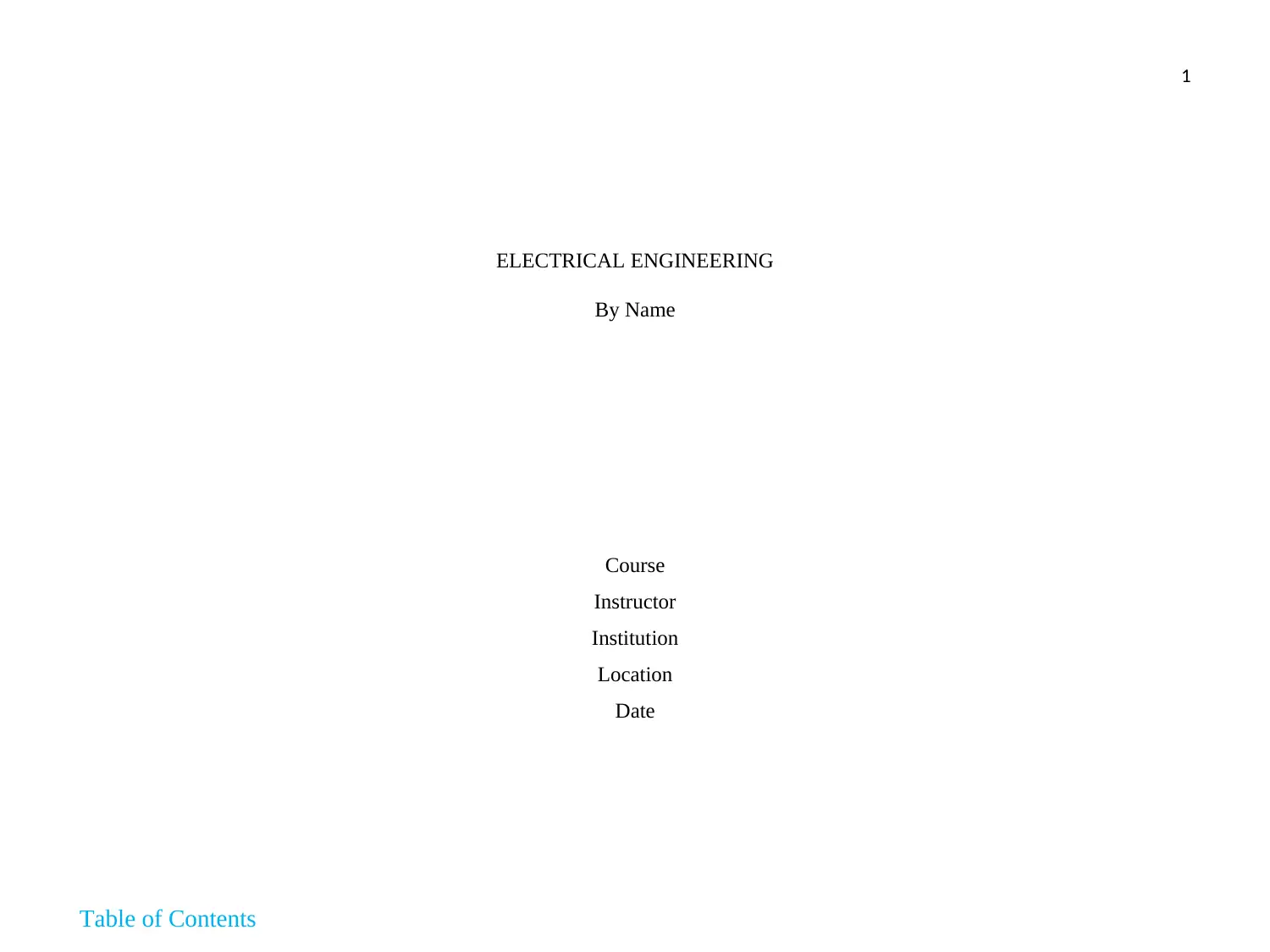
1
ELECTRICAL ENGINEERING
By Name
Course
Instructor
Institution
Location
Date
Table of Contents
ELECTRICAL ENGINEERING
By Name
Course
Instructor
Institution
Location
Date
Table of Contents
Paraphrase This Document
Need a fresh take? Get an instant paraphrase of this document with our AI Paraphraser

2
Executive summary...............................................................................................................................................................................3
CHAPTER 1.........................................................................................................................................................................................4
Introduction............................................................................................................................................................................................4
1.1 Background......................................................................................................................................................................................4
1.2 Study objectives...............................................................................................................................................................................5
1.3 Scope of the project.........................................................................................................................................................................6
1.4 Organisation of the report................................................................................................................................................................6
CHAPTER 2.........................................................................................................................................................................................8
Literature review....................................................................................................................................................................................8
2.1 Smart Grids......................................................................................................................................................................................8
2.2 Microgrids......................................................................................................................................................................................10
2.3 Energy sharing scenario in microgrid............................................................................................................................................13
2.4 Benefits of energy sharing in smart microgrid..............................................................................................................................14
2.5 Auction based pricing strategy for energy sharing........................................................................................................................14
Executive summary...............................................................................................................................................................................3
CHAPTER 1.........................................................................................................................................................................................4
Introduction............................................................................................................................................................................................4
1.1 Background......................................................................................................................................................................................4
1.2 Study objectives...............................................................................................................................................................................5
1.3 Scope of the project.........................................................................................................................................................................6
1.4 Organisation of the report................................................................................................................................................................6
CHAPTER 2.........................................................................................................................................................................................8
Literature review....................................................................................................................................................................................8
2.1 Smart Grids......................................................................................................................................................................................8
2.2 Microgrids......................................................................................................................................................................................10
2.3 Energy sharing scenario in microgrid............................................................................................................................................13
2.4 Benefits of energy sharing in smart microgrid..............................................................................................................................14
2.5 Auction based pricing strategy for energy sharing........................................................................................................................14

3
CHAPTER 3.......................................................................................................................................................................................17
Methodology........................................................................................................................................................................................17
3.1 Case studies...................................................................................................................................................................................17
3.2 Secondary sources.........................................................................................................................................................................18
3.3 Game Theory.................................................................................................................................................................................18
3.4 System Model................................................................................................................................................................................19
CHAPTER 4.......................................................................................................................................................................................21
Results & Discussions.........................................................................................................................................................................21
CHAPTER 5.......................................................................................................................................................................................27
Concluding remarks.............................................................................................................................................................................27
CHAPTER 6.......................................................................................................................................................................................29
References............................................................................................................................................................................................29
Appendices..........................................................................................................................................................................................31
CHAPTER 3.......................................................................................................................................................................................17
Methodology........................................................................................................................................................................................17
3.1 Case studies...................................................................................................................................................................................17
3.2 Secondary sources.........................................................................................................................................................................18
3.3 Game Theory.................................................................................................................................................................................18
3.4 System Model................................................................................................................................................................................19
CHAPTER 4.......................................................................................................................................................................................21
Results & Discussions.........................................................................................................................................................................21
CHAPTER 5.......................................................................................................................................................................................27
Concluding remarks.............................................................................................................................................................................27
CHAPTER 6.......................................................................................................................................................................................29
References............................................................................................................................................................................................29
Appendices..........................................................................................................................................................................................31
⊘ This is a preview!⊘
Do you want full access?
Subscribe today to unlock all pages.

Trusted by 1+ million students worldwide

4
Executive summary
With the rapid increase in installation and demand of energy, many power consumers have been forced to become prosumers who
can both consume and generate energy. This study primary focuses on the Development of optimum pricing strategy for energy
sharing in a smart community Micro grid. Targets such as energy conservation, demand response, reduction of carbon footprint,
improved reliability, high penetration of renewable sources of energy and improving efficiency cannot be solved by using the
existing conventional electricity grid, this has called for the modernization of the convention power grid system to the modern
smart grid systems where ICT plays a significant role. Microgrid refers to a set of loads for households, distributed energy
resources (e.g. solar panels), and possibly an Energy storage System such as batteries, operating as a single controlled system
which provides power energy to its local area. The main advantages of sharing energy are: Saves money for those who buy the
excess energy from the prosumers, the tariff rates of the prosumers tends to be much lower as compared to those of main grid.
There are no middlemen who are involved in the trade, thus the consumers and prosumers can be able to carry out their business
on their own terms.
Executive summary
With the rapid increase in installation and demand of energy, many power consumers have been forced to become prosumers who
can both consume and generate energy. This study primary focuses on the Development of optimum pricing strategy for energy
sharing in a smart community Micro grid. Targets such as energy conservation, demand response, reduction of carbon footprint,
improved reliability, high penetration of renewable sources of energy and improving efficiency cannot be solved by using the
existing conventional electricity grid, this has called for the modernization of the convention power grid system to the modern
smart grid systems where ICT plays a significant role. Microgrid refers to a set of loads for households, distributed energy
resources (e.g. solar panels), and possibly an Energy storage System such as batteries, operating as a single controlled system
which provides power energy to its local area. The main advantages of sharing energy are: Saves money for those who buy the
excess energy from the prosumers, the tariff rates of the prosumers tends to be much lower as compared to those of main grid.
There are no middlemen who are involved in the trade, thus the consumers and prosumers can be able to carry out their business
on their own terms.
Paraphrase This Document
Need a fresh take? Get an instant paraphrase of this document with our AI Paraphraser
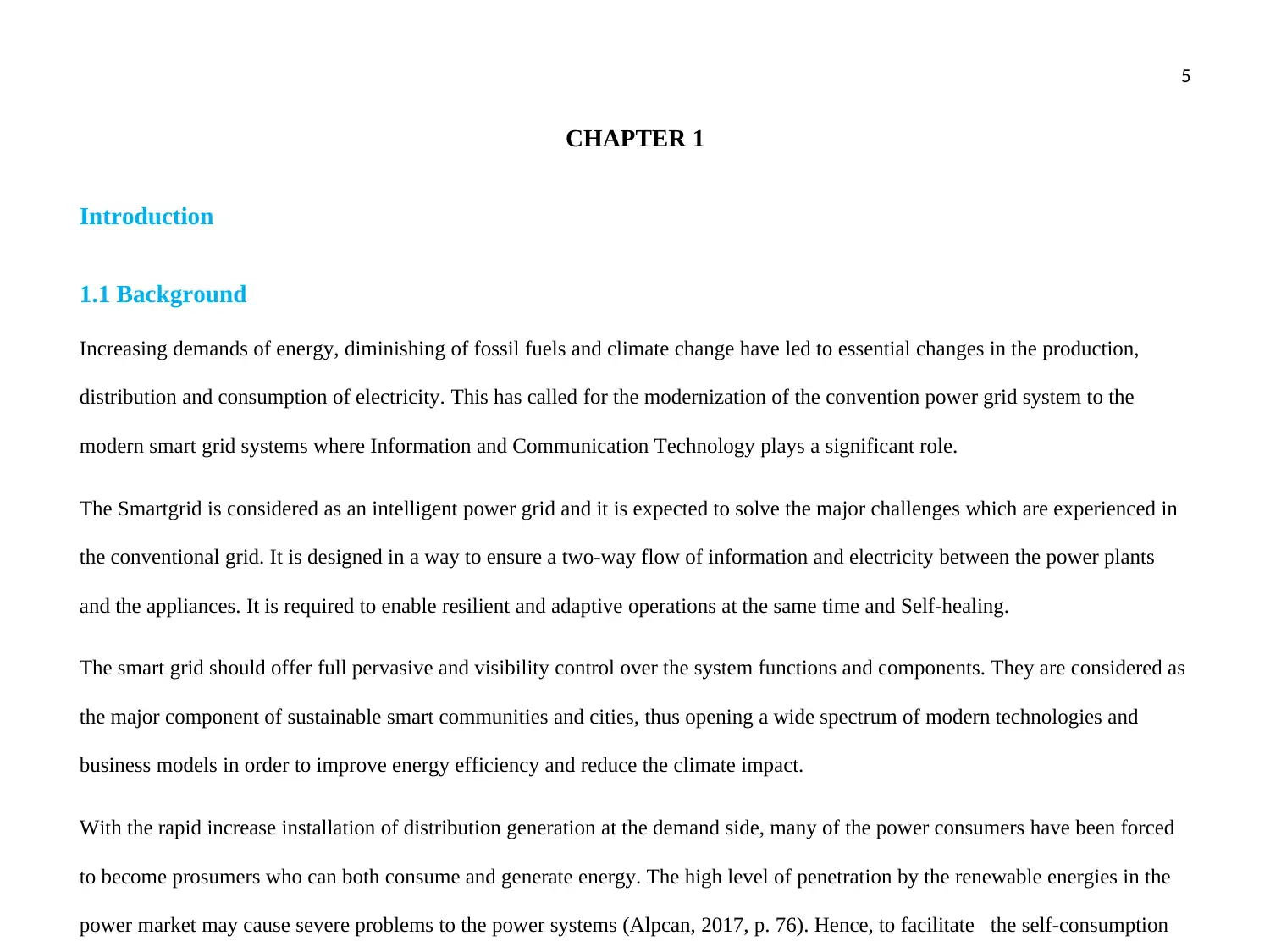
5
CHAPTER 1
Introduction
1.1 Background
Increasing demands of energy, diminishing of fossil fuels and climate change have led to essential changes in the production,
distribution and consumption of electricity. This has called for the modernization of the convention power grid system to the
modern smart grid systems where Information and Communication Technology plays a significant role.
The Smartgrid is considered as an intelligent power grid and it is expected to solve the major challenges which are experienced in
the conventional grid. It is designed in a way to ensure a two-way flow of information and electricity between the power plants
and the appliances. It is required to enable resilient and adaptive operations at the same time and Self-healing.
The smart grid should offer full pervasive and visibility control over the system functions and components. They are considered as
the major component of sustainable smart communities and cities, thus opening a wide spectrum of modern technologies and
business models in order to improve energy efficiency and reduce the climate impact.
With the rapid increase installation of distribution generation at the demand side, many of the power consumers have been forced
to become prosumers who can both consume and generate energy. The high level of penetration by the renewable energies in the
power market may cause severe problems to the power systems (Alpcan, 2017, p. 76). Hence, to facilitate the self-consumption
CHAPTER 1
Introduction
1.1 Background
Increasing demands of energy, diminishing of fossil fuels and climate change have led to essential changes in the production,
distribution and consumption of electricity. This has called for the modernization of the convention power grid system to the
modern smart grid systems where Information and Communication Technology plays a significant role.
The Smartgrid is considered as an intelligent power grid and it is expected to solve the major challenges which are experienced in
the conventional grid. It is designed in a way to ensure a two-way flow of information and electricity between the power plants
and the appliances. It is required to enable resilient and adaptive operations at the same time and Self-healing.
The smart grid should offer full pervasive and visibility control over the system functions and components. They are considered as
the major component of sustainable smart communities and cities, thus opening a wide spectrum of modern technologies and
business models in order to improve energy efficiency and reduce the climate impact.
With the rapid increase installation of distribution generation at the demand side, many of the power consumers have been forced
to become prosumers who can both consume and generate energy. The high level of penetration by the renewable energies in the
power market may cause severe problems to the power systems (Alpcan, 2017, p. 76). Hence, to facilitate the self-consumption
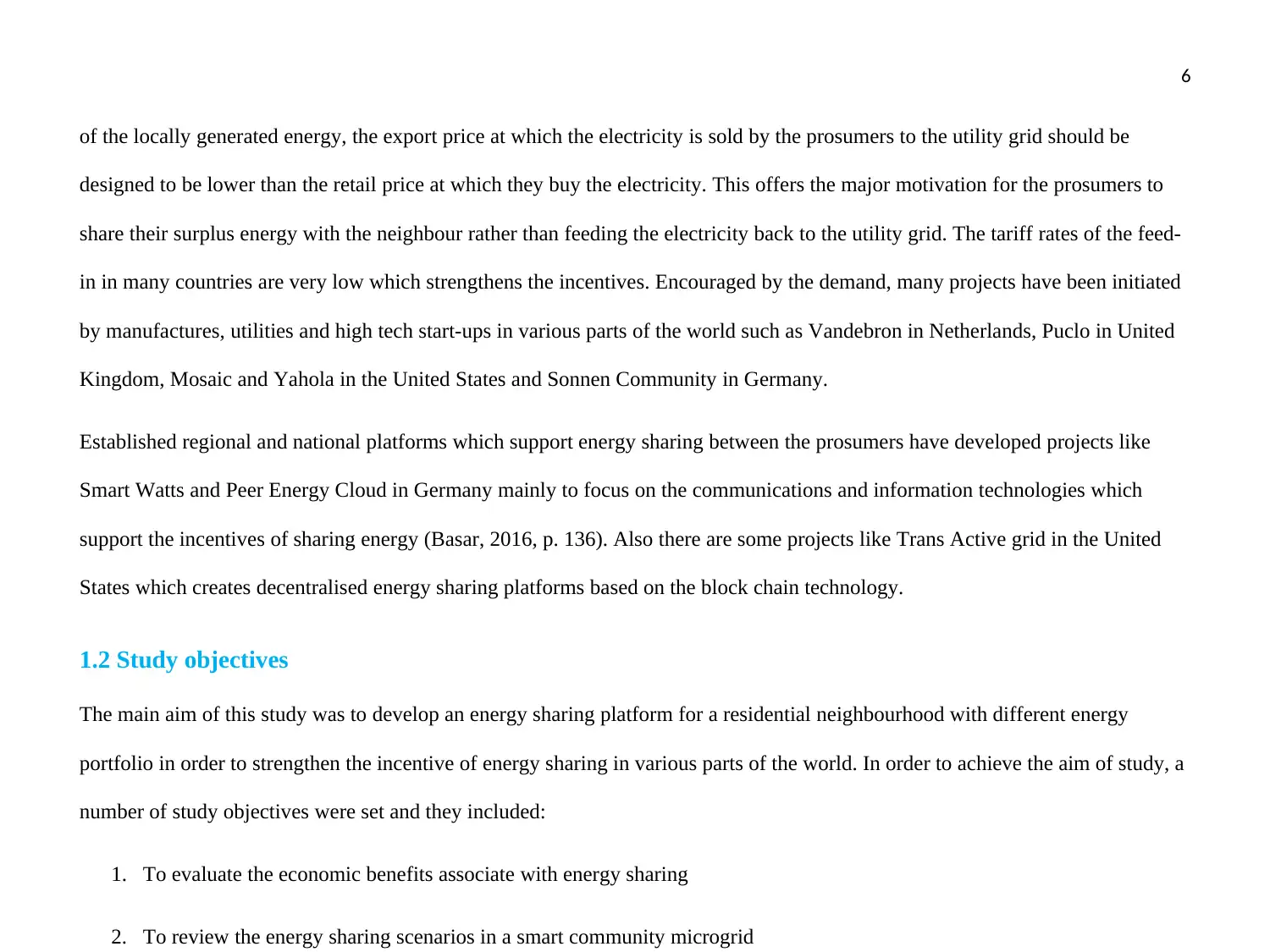
6
of the locally generated energy, the export price at which the electricity is sold by the prosumers to the utility grid should be
designed to be lower than the retail price at which they buy the electricity. This offers the major motivation for the prosumers to
share their surplus energy with the neighbour rather than feeding the electricity back to the utility grid. The tariff rates of the feed-
in in many countries are very low which strengthens the incentives. Encouraged by the demand, many projects have been initiated
by manufactures, utilities and high tech start-ups in various parts of the world such as Vandebron in Netherlands, Puclo in United
Kingdom, Mosaic and Yahola in the United States and Sonnen Community in Germany.
Established regional and national platforms which support energy sharing between the prosumers have developed projects like
Smart Watts and Peer Energy Cloud in Germany mainly to focus on the communications and information technologies which
support the incentives of sharing energy (Basar, 2016, p. 136). Also there are some projects like Trans Active grid in the United
States which creates decentralised energy sharing platforms based on the block chain technology.
1.2 Study objectives
The main aim of this study was to develop an energy sharing platform for a residential neighbourhood with different energy
portfolio in order to strengthen the incentive of energy sharing in various parts of the world. In order to achieve the aim of study, a
number of study objectives were set and they included:
1. To evaluate the economic benefits associate with energy sharing
2. To review the energy sharing scenarios in a smart community microgrid
of the locally generated energy, the export price at which the electricity is sold by the prosumers to the utility grid should be
designed to be lower than the retail price at which they buy the electricity. This offers the major motivation for the prosumers to
share their surplus energy with the neighbour rather than feeding the electricity back to the utility grid. The tariff rates of the feed-
in in many countries are very low which strengthens the incentives. Encouraged by the demand, many projects have been initiated
by manufactures, utilities and high tech start-ups in various parts of the world such as Vandebron in Netherlands, Puclo in United
Kingdom, Mosaic and Yahola in the United States and Sonnen Community in Germany.
Established regional and national platforms which support energy sharing between the prosumers have developed projects like
Smart Watts and Peer Energy Cloud in Germany mainly to focus on the communications and information technologies which
support the incentives of sharing energy (Basar, 2016, p. 136). Also there are some projects like Trans Active grid in the United
States which creates decentralised energy sharing platforms based on the block chain technology.
1.2 Study objectives
The main aim of this study was to develop an energy sharing platform for a residential neighbourhood with different energy
portfolio in order to strengthen the incentive of energy sharing in various parts of the world. In order to achieve the aim of study, a
number of study objectives were set and they included:
1. To evaluate the economic benefits associate with energy sharing
2. To review the energy sharing scenarios in a smart community microgrid
⊘ This is a preview!⊘
Do you want full access?
Subscribe today to unlock all pages.

Trusted by 1+ million students worldwide
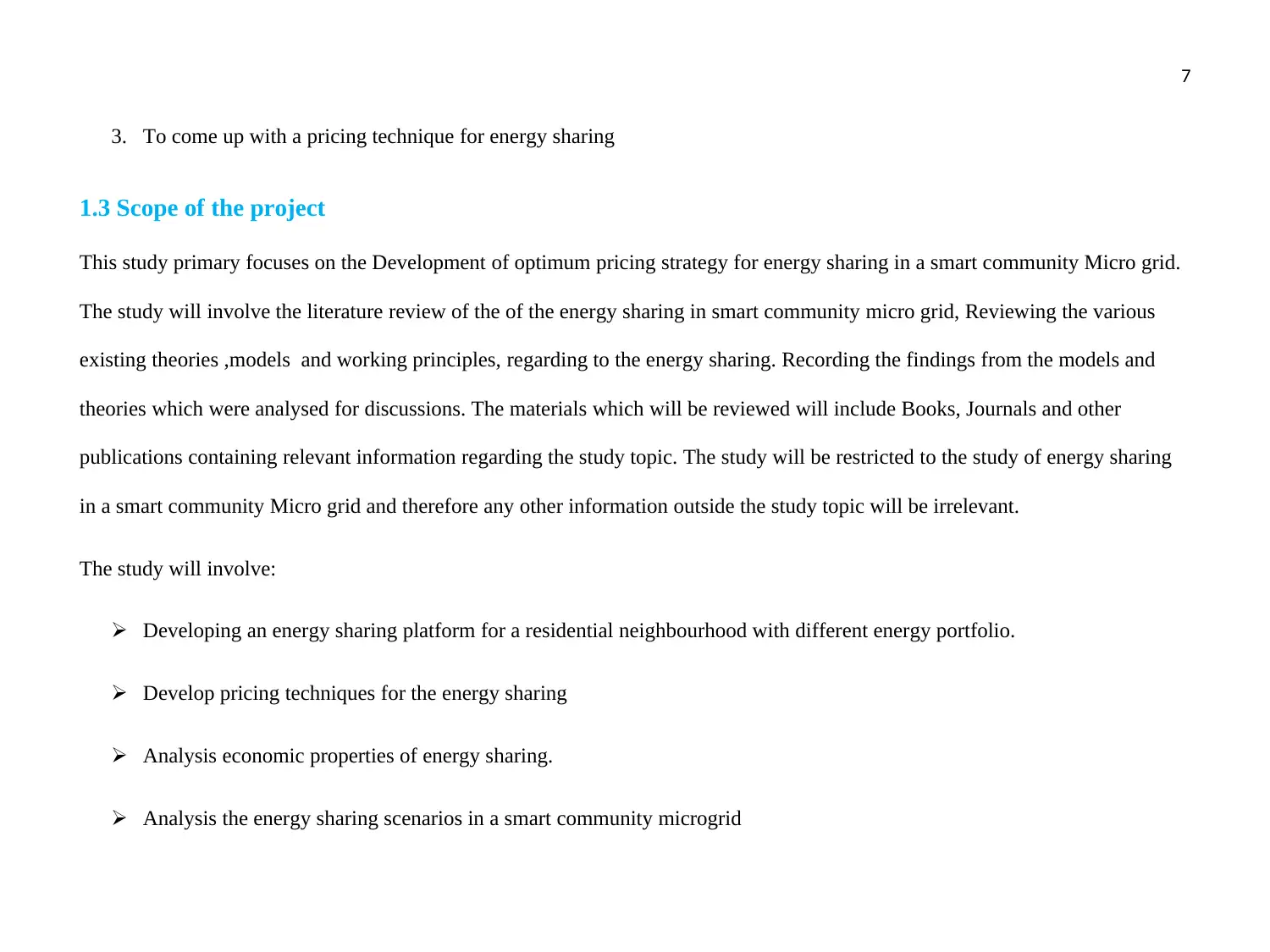
7
3. To come up with a pricing technique for energy sharing
1.3 Scope of the project
This study primary focuses on the Development of optimum pricing strategy for energy sharing in a smart community Micro grid.
The study will involve the literature review of the of the energy sharing in smart community micro grid, Reviewing the various
existing theories ,models and working principles, regarding to the energy sharing. Recording the findings from the models and
theories which were analysed for discussions. The materials which will be reviewed will include Books, Journals and other
publications containing relevant information regarding the study topic. The study will be restricted to the study of energy sharing
in a smart community Micro grid and therefore any other information outside the study topic will be irrelevant.
The study will involve:
Developing an energy sharing platform for a residential neighbourhood with different energy portfolio.
Develop pricing techniques for the energy sharing
Analysis economic properties of energy sharing.
Analysis the energy sharing scenarios in a smart community microgrid
3. To come up with a pricing technique for energy sharing
1.3 Scope of the project
This study primary focuses on the Development of optimum pricing strategy for energy sharing in a smart community Micro grid.
The study will involve the literature review of the of the energy sharing in smart community micro grid, Reviewing the various
existing theories ,models and working principles, regarding to the energy sharing. Recording the findings from the models and
theories which were analysed for discussions. The materials which will be reviewed will include Books, Journals and other
publications containing relevant information regarding the study topic. The study will be restricted to the study of energy sharing
in a smart community Micro grid and therefore any other information outside the study topic will be irrelevant.
The study will involve:
Developing an energy sharing platform for a residential neighbourhood with different energy portfolio.
Develop pricing techniques for the energy sharing
Analysis economic properties of energy sharing.
Analysis the energy sharing scenarios in a smart community microgrid
Paraphrase This Document
Need a fresh take? Get an instant paraphrase of this document with our AI Paraphraser
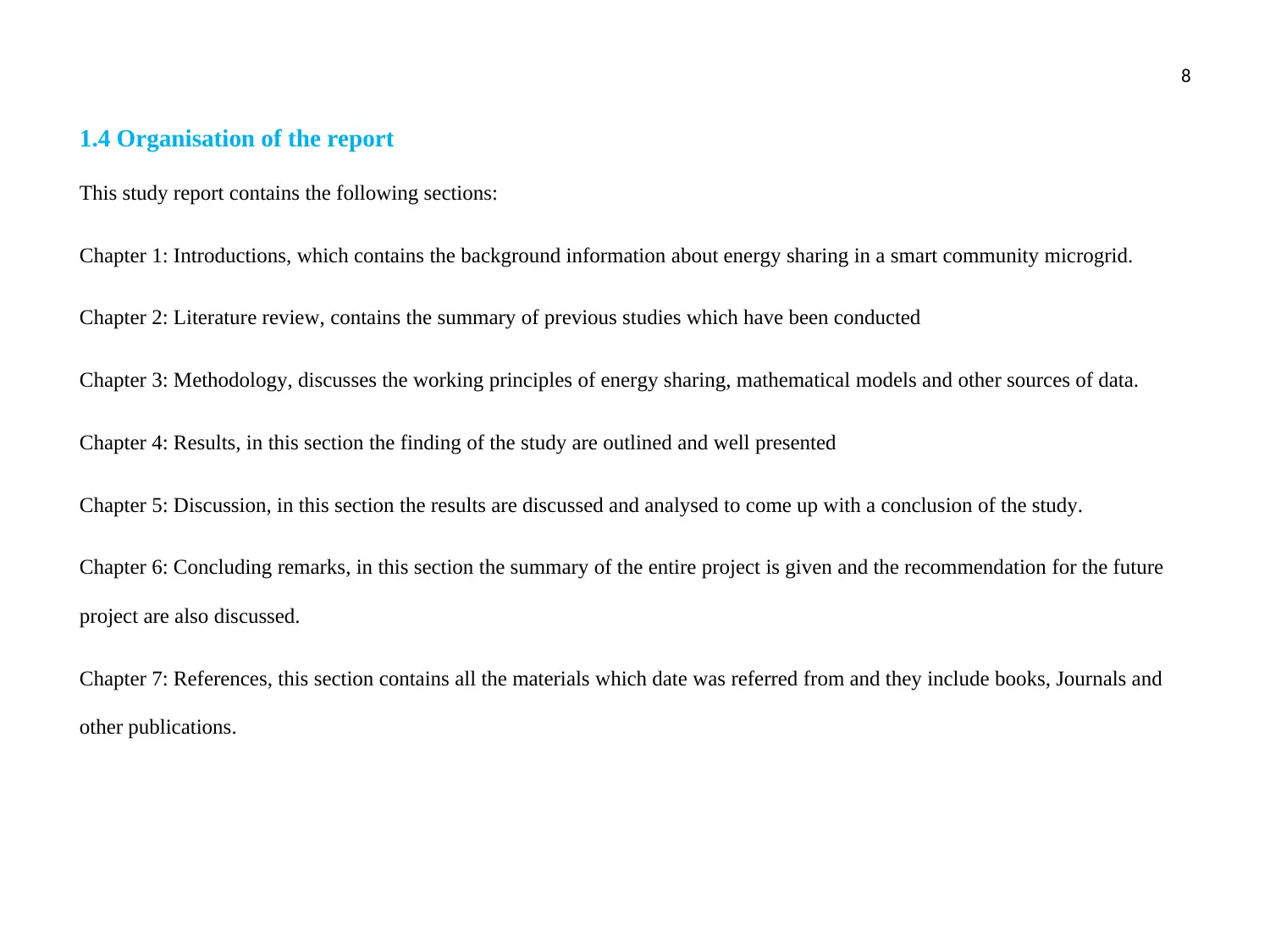
8
1.4 Organisation of the report
This study report contains the following sections:
Chapter 1: Introductions, which contains the background information about energy sharing in a smart community microgrid.
Chapter 2: Literature review, contains the summary of previous studies which have been conducted
Chapter 3: Methodology, discusses the working principles of energy sharing, mathematical models and other sources of data.
Chapter 4: Results, in this section the finding of the study are outlined and well presented
Chapter 5: Discussion, in this section the results are discussed and analysed to come up with a conclusion of the study.
Chapter 6: Concluding remarks, in this section the summary of the entire project is given and the recommendation for the future
project are also discussed.
Chapter 7: References, this section contains all the materials which date was referred from and they include books, Journals and
other publications.
1.4 Organisation of the report
This study report contains the following sections:
Chapter 1: Introductions, which contains the background information about energy sharing in a smart community microgrid.
Chapter 2: Literature review, contains the summary of previous studies which have been conducted
Chapter 3: Methodology, discusses the working principles of energy sharing, mathematical models and other sources of data.
Chapter 4: Results, in this section the finding of the study are outlined and well presented
Chapter 5: Discussion, in this section the results are discussed and analysed to come up with a conclusion of the study.
Chapter 6: Concluding remarks, in this section the summary of the entire project is given and the recommendation for the future
project are also discussed.
Chapter 7: References, this section contains all the materials which date was referred from and they include books, Journals and
other publications.
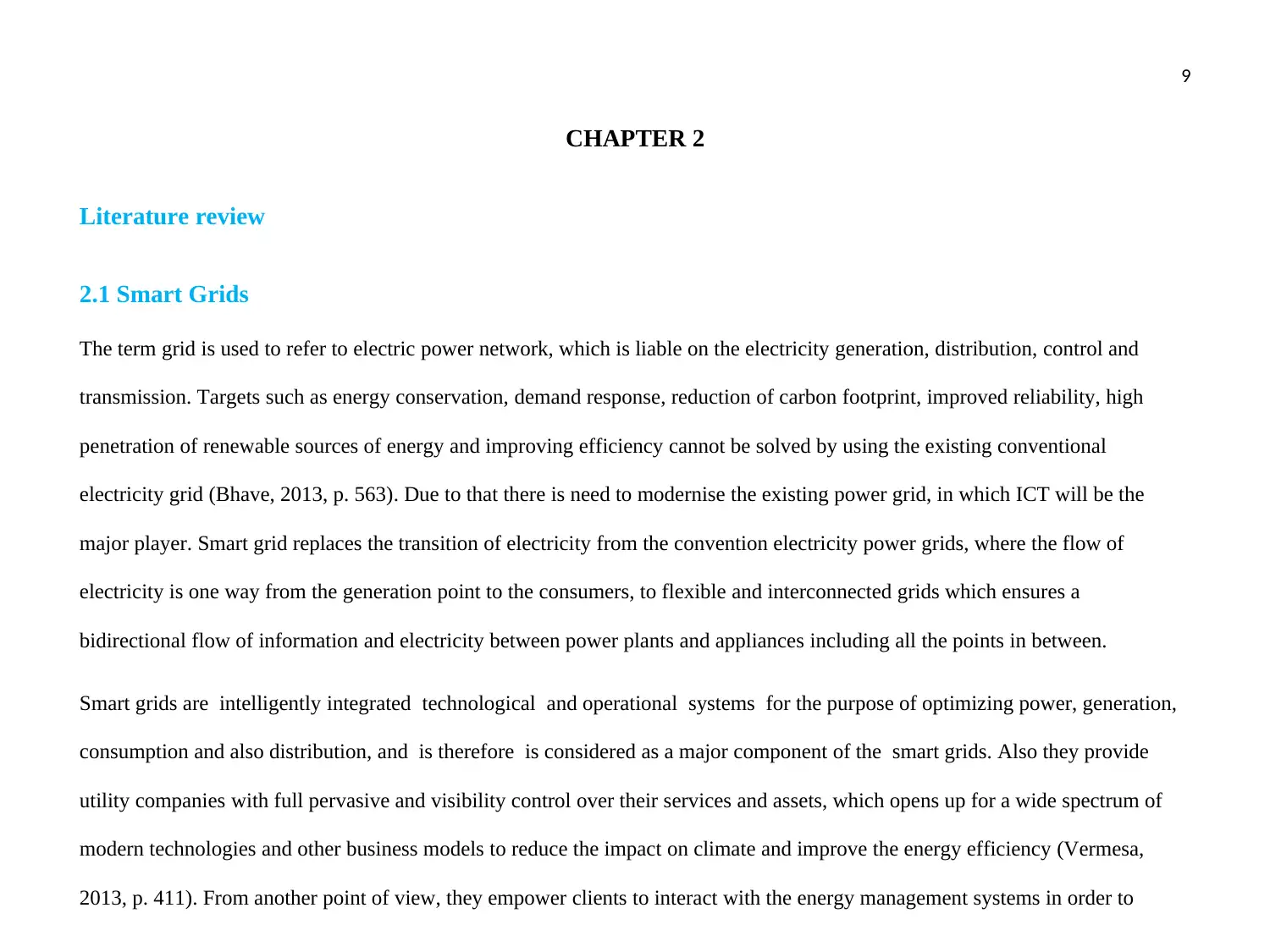
9
CHAPTER 2
Literature review
2.1 Smart Grids
The term grid is used to refer to electric power network, which is liable on the electricity generation, distribution, control and
transmission. Targets such as energy conservation, demand response, reduction of carbon footprint, improved reliability, high
penetration of renewable sources of energy and improving efficiency cannot be solved by using the existing conventional
electricity grid (Bhave, 2013, p. 563). Due to that there is need to modernise the existing power grid, in which ICT will be the
major player. Smart grid replaces the transition of electricity from the convention electricity power grids, where the flow of
electricity is one way from the generation point to the consumers, to flexible and interconnected grids which ensures a
bidirectional flow of information and electricity between power plants and appliances including all the points in between.
Smart grids are intelligently integrated technological and operational systems for the purpose of optimizing power, generation,
consumption and also distribution, and is therefore is considered as a major component of the smart grids. Also they provide
utility companies with full pervasive and visibility control over their services and assets, which opens up for a wide spectrum of
modern technologies and other business models to reduce the impact on climate and improve the energy efficiency (Vermesa,
2013, p. 411). From another point of view, they empower clients to interact with the energy management systems in order to
CHAPTER 2
Literature review
2.1 Smart Grids
The term grid is used to refer to electric power network, which is liable on the electricity generation, distribution, control and
transmission. Targets such as energy conservation, demand response, reduction of carbon footprint, improved reliability, high
penetration of renewable sources of energy and improving efficiency cannot be solved by using the existing conventional
electricity grid (Bhave, 2013, p. 563). Due to that there is need to modernise the existing power grid, in which ICT will be the
major player. Smart grid replaces the transition of electricity from the convention electricity power grids, where the flow of
electricity is one way from the generation point to the consumers, to flexible and interconnected grids which ensures a
bidirectional flow of information and electricity between power plants and appliances including all the points in between.
Smart grids are intelligently integrated technological and operational systems for the purpose of optimizing power, generation,
consumption and also distribution, and is therefore is considered as a major component of the smart grids. Also they provide
utility companies with full pervasive and visibility control over their services and assets, which opens up for a wide spectrum of
modern technologies and other business models to reduce the impact on climate and improve the energy efficiency (Vermesa,
2013, p. 411). From another point of view, they empower clients to interact with the energy management systems in order to
⊘ This is a preview!⊘
Do you want full access?
Subscribe today to unlock all pages.

Trusted by 1+ million students worldwide
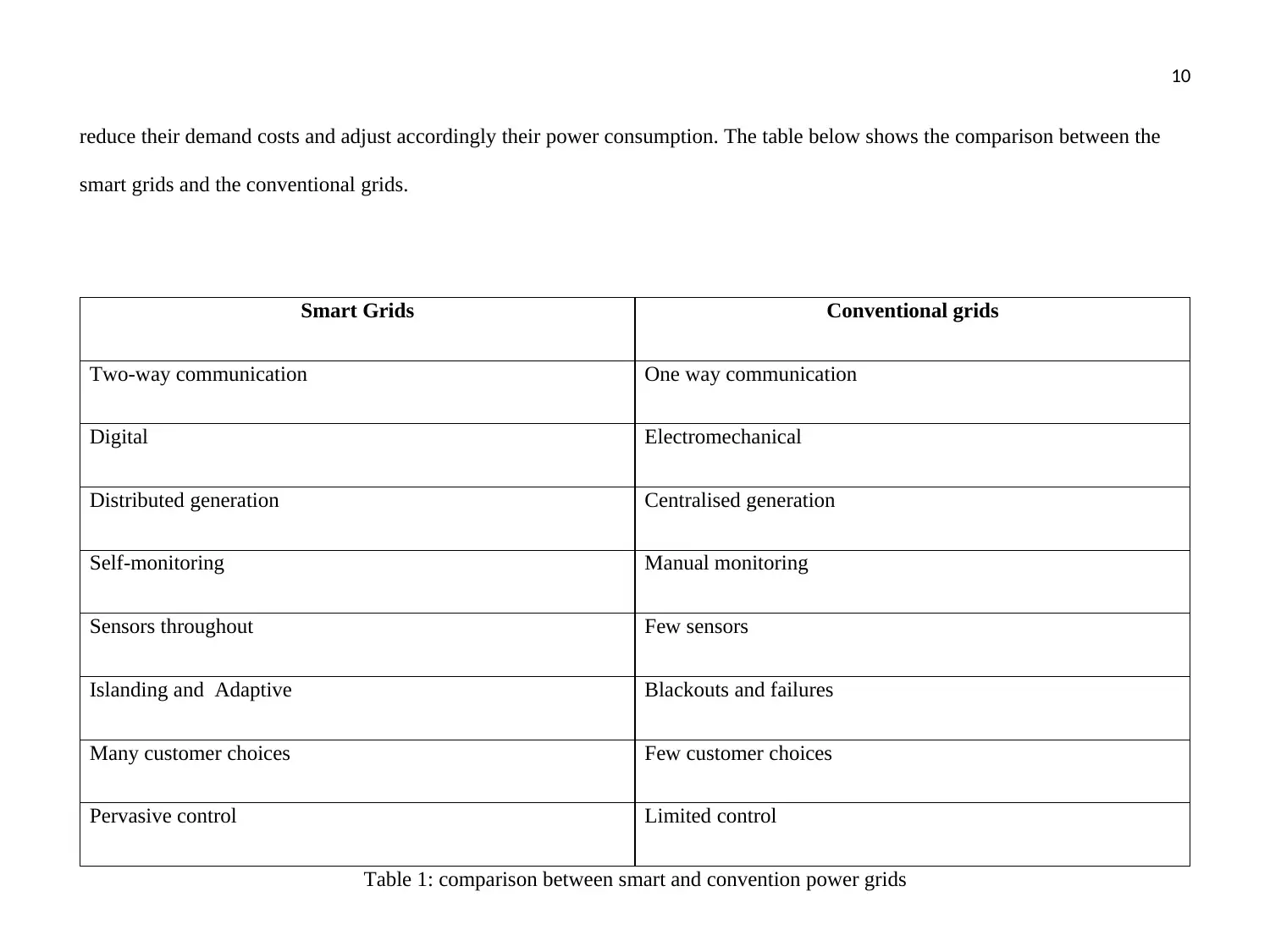
10
reduce their demand costs and adjust accordingly their power consumption. The table below shows the comparison between the
smart grids and the conventional grids.
Smart Grids Conventional grids
Two-way communication One way communication
Digital Electromechanical
Distributed generation Centralised generation
Self-monitoring Manual monitoring
Sensors throughout Few sensors
Islanding and Adaptive Blackouts and failures
Many customer choices Few customer choices
Pervasive control Limited control
Table 1: comparison between smart and convention power grids
reduce their demand costs and adjust accordingly their power consumption. The table below shows the comparison between the
smart grids and the conventional grids.
Smart Grids Conventional grids
Two-way communication One way communication
Digital Electromechanical
Distributed generation Centralised generation
Self-monitoring Manual monitoring
Sensors throughout Few sensors
Islanding and Adaptive Blackouts and failures
Many customer choices Few customer choices
Pervasive control Limited control
Table 1: comparison between smart and convention power grids
Paraphrase This Document
Need a fresh take? Get an instant paraphrase of this document with our AI Paraphraser
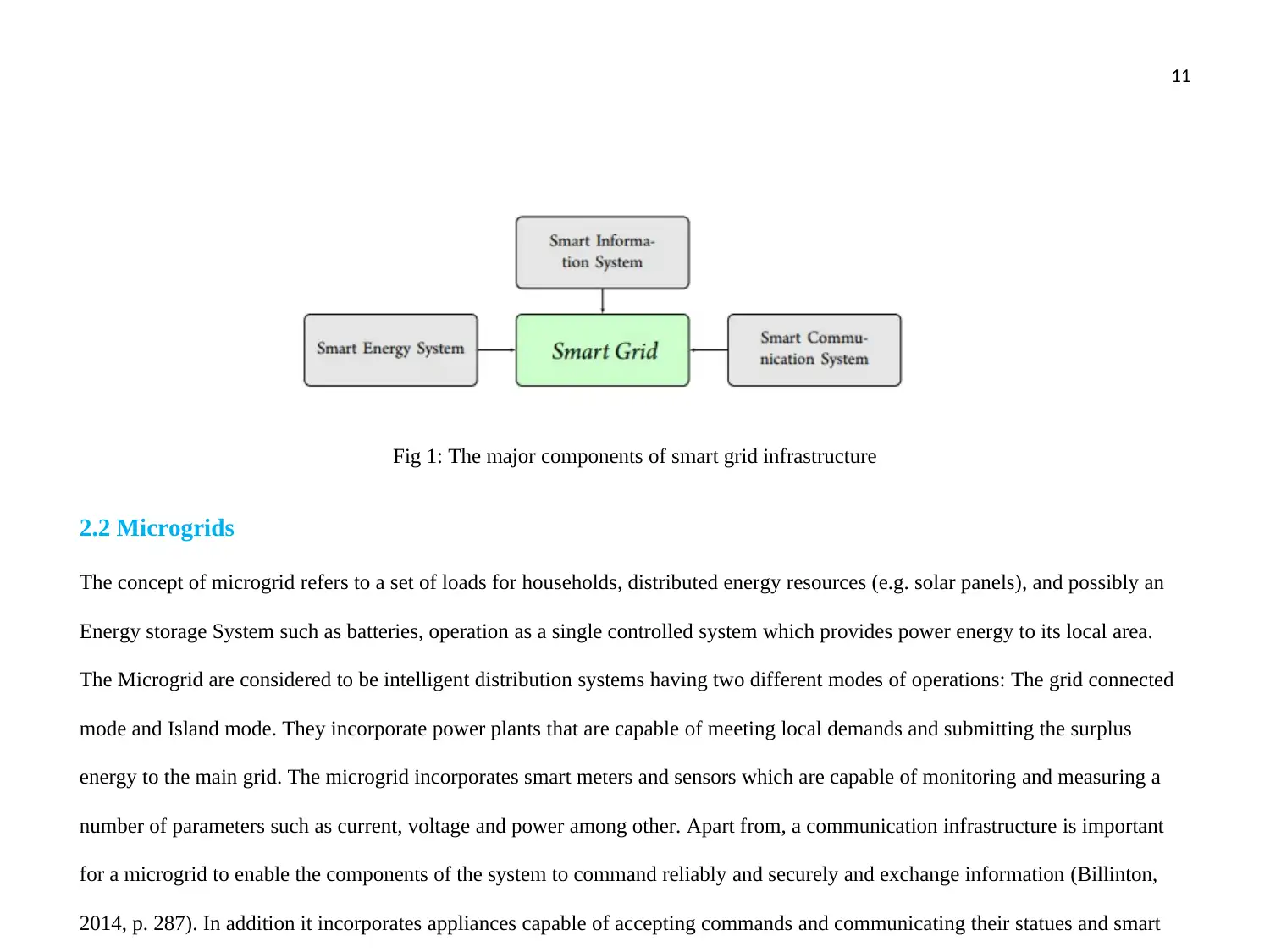
11
Fig 1: The major components of smart grid infrastructure
2.2 Microgrids
The concept of microgrid refers to a set of loads for households, distributed energy resources (e.g. solar panels), and possibly an
Energy storage System such as batteries, operation as a single controlled system which provides power energy to its local area.
The Microgrid are considered to be intelligent distribution systems having two different modes of operations: The grid connected
mode and Island mode. They incorporate power plants that are capable of meeting local demands and submitting the surplus
energy to the main grid. The microgrid incorporates smart meters and sensors which are capable of monitoring and measuring a
number of parameters such as current, voltage and power among other. Apart from, a communication infrastructure is important
for a microgrid to enable the components of the system to command reliably and securely and exchange information (Billinton,
2014, p. 287). In addition it incorporates appliances capable of accepting commands and communicating their statues and smart
Fig 1: The major components of smart grid infrastructure
2.2 Microgrids
The concept of microgrid refers to a set of loads for households, distributed energy resources (e.g. solar panels), and possibly an
Energy storage System such as batteries, operation as a single controlled system which provides power energy to its local area.
The Microgrid are considered to be intelligent distribution systems having two different modes of operations: The grid connected
mode and Island mode. They incorporate power plants that are capable of meeting local demands and submitting the surplus
energy to the main grid. The microgrid incorporates smart meters and sensors which are capable of monitoring and measuring a
number of parameters such as current, voltage and power among other. Apart from, a communication infrastructure is important
for a microgrid to enable the components of the system to command reliably and securely and exchange information (Billinton,
2014, p. 287). In addition it incorporates appliances capable of accepting commands and communicating their statues and smart
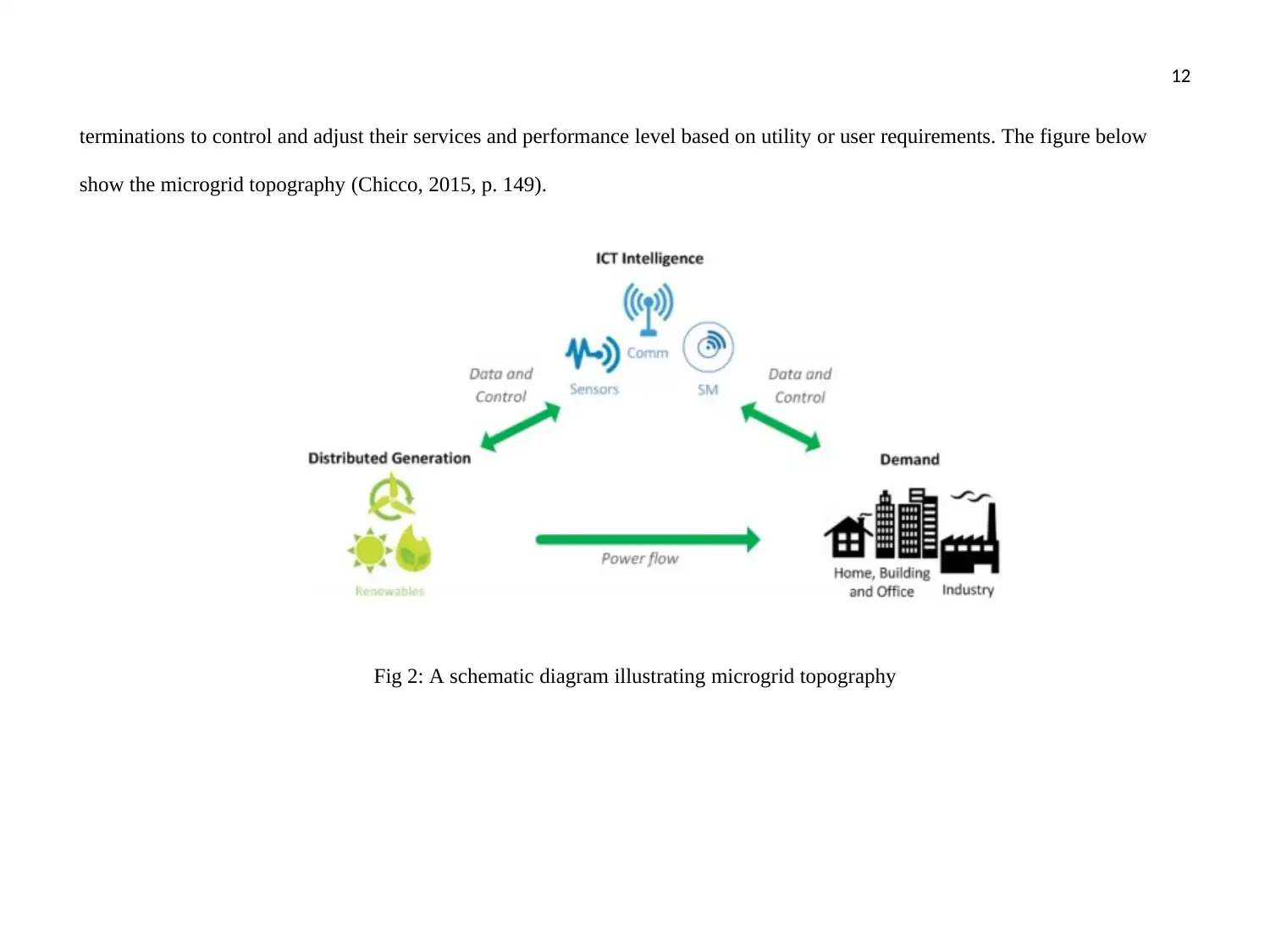
12
terminations to control and adjust their services and performance level based on utility or user requirements. The figure below
show the microgrid topography (Chicco, 2015, p. 149).
Fig 2: A schematic diagram illustrating microgrid topography
terminations to control and adjust their services and performance level based on utility or user requirements. The figure below
show the microgrid topography (Chicco, 2015, p. 149).
Fig 2: A schematic diagram illustrating microgrid topography
⊘ This is a preview!⊘
Do you want full access?
Subscribe today to unlock all pages.

Trusted by 1+ million students worldwide
1 out of 33
Related Documents
Your All-in-One AI-Powered Toolkit for Academic Success.
+13062052269
info@desklib.com
Available 24*7 on WhatsApp / Email
![[object Object]](/_next/static/media/star-bottom.7253800d.svg)
Unlock your academic potential
Copyright © 2020–2025 A2Z Services. All Rights Reserved. Developed and managed by ZUCOL.





